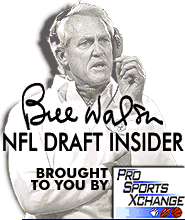
How I Evaluate Each Position:
Fullback
By Bill Walsh
PSX Draft Insider Special
|
|
How I Evaluate Each Position: Fullback By Bill Walsh PSX Draft Insider Special |
FULLBACK
Ideal size: 6-1, 245
The fullback position parallels the tight end in many ways. It depends on the emphasis of the system of offense and also what type fullback you have available.
If you have a devastating blocker, then he, like the great blocking tight end, can be the focal point of the offense. You can direct them at any defender near the line of scrimmage and they can effectively block them a high percentage of the time. So that allows you any number of running combinations in your running game. And in pass protection, if they are stout enough they can, if necessary, occasionally take on a defensive lineman. That could be either as a replacement block or to clean up on people.
So ballast is important. Strength, girth and ballast. For that blocking-type fullback, speed is not a major factor. You'd like to have him under 5-flat (in 40 yards) and, typically, 6-1, 250.
This type fullback must be able to focus on a specific defender, find him and take him. It could be an inside linebacker, an outside linebacker or a defensive lineman. But he must know how to find him, know how to read what happens and make the play.
That means he must be functionally intelligent enough to handle the variables that occur in order to be a consistent blocker.
They must have outstanding durability because they probably have more significant contact than anybody else on the field when you consider the velocity of the hits. Play after play a Tom Rathman or a Daryl Johnston would have major contact if you follow him through a game.
So durability, girth, strength, the ability to focus and identify and then the ability to take on the best pass rusher -- an outside linebacker or defensive end -- and find a way to take care of him.
Then the other area is receiving. If they are adequate receivers, then they can be a functional fullback. As an outlet receiver, releasing last out of the backfield, they often get the ball clear of defenders and have a chance to get a running start at the linebackers who are going to tackle him. Again, Rathman and Johnston are examples.
Then there is the other type of fullback. Kind of a halfback playing fullback, like Roger Craig did for the 49ers. In this case, you have to fashion your offense as to what this fullback's skills or talents may be. The 49ers' greatest team, in 1984, had Craig at fullback and Wendell Tyler at halfback. So this type of athlete is a skilled player. His blocking has to be adequate, just meet minimal standards.
Still, he can be the focal point of the offensive firepower because from his position he can be a receiver, ball-carrier go anywhere, as Roger Craig did. He can be a 1,000- yard ball carrier. With this type of athlete, you have to gear your line blocking combinations to accommodate a non-blocking fullback. This limits what you can do in certain ways, but it expands it offensively when he has the ball.
Naturally, on occasion there is going to be the great all around fullback. Franco Harris was like that. John L. Williams with Seattle was another like that.